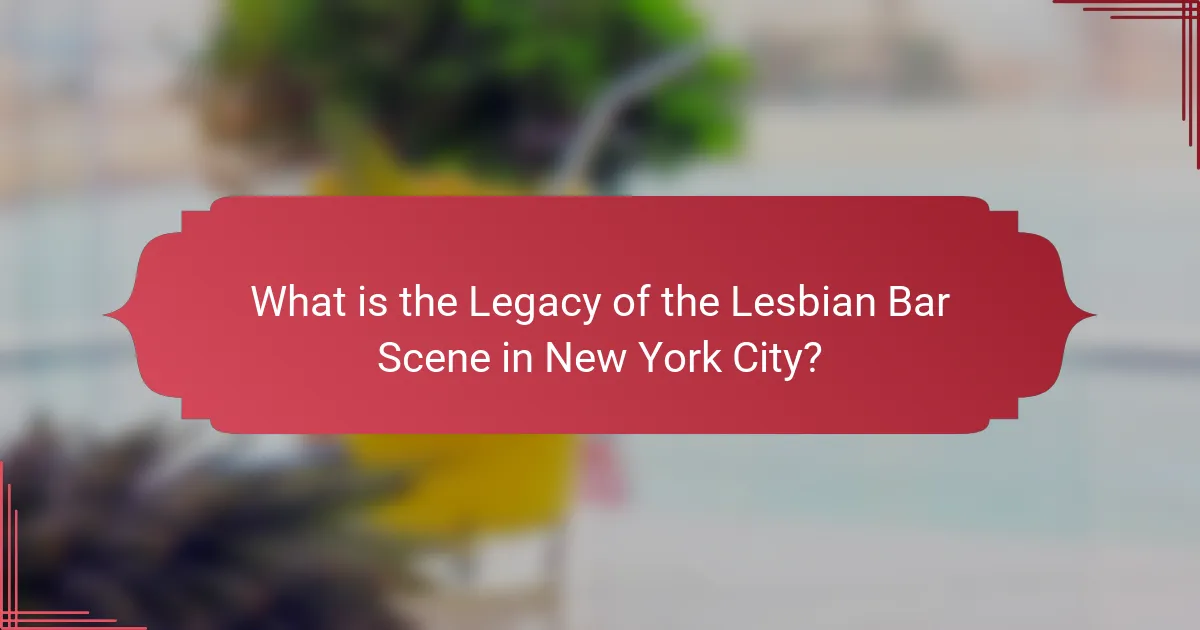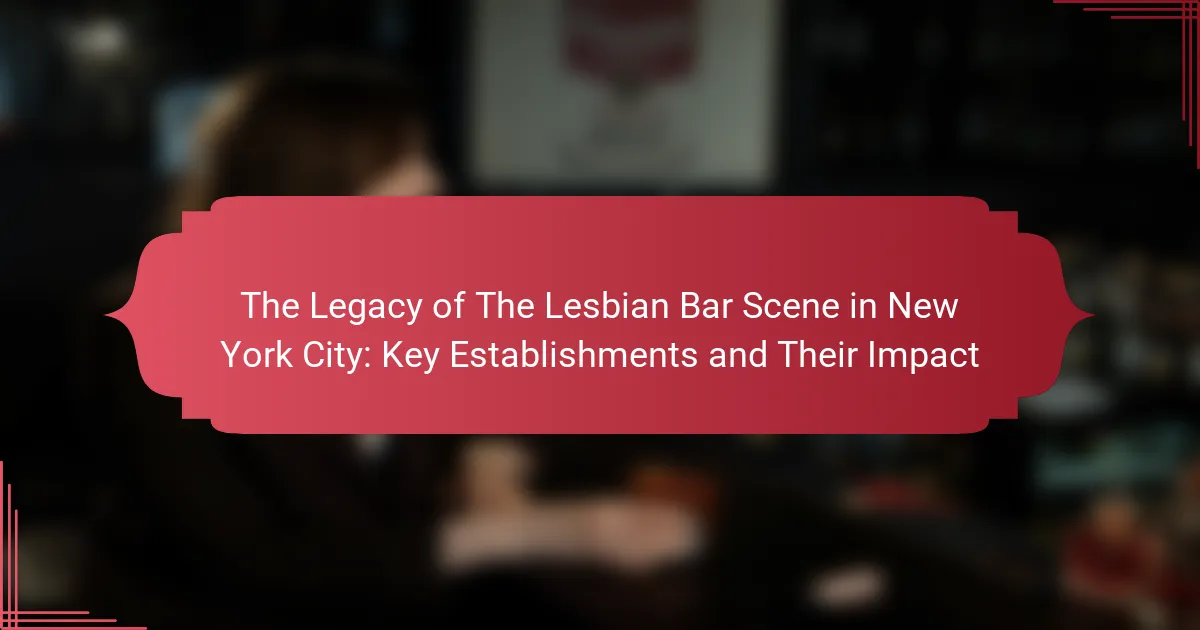
What is the Legacy of the Lesbian Bar Scene in New York City?
The legacy of the lesbian bar scene in New York City is significant in [censured] history. These establishments provided safe spaces for women to express their identities. They fostered community and solidarity among lesbians during times of societal oppression. Notable bars like The Cubbyhole and Henrietta Hudson became cultural landmarks. The scene played a role in activism and visibility for lesbian rights. Events hosted in these bars often sparked wider movements. The bars also contributed to the nightlife and cultural landscape of the city. Their influence continues to resonate in contemporary [censured] spaces.
How did the lesbian bar scene in New York City evolve over time?
The lesbian bar scene in New York City evolved significantly from the early 20th century to the present. Initially, lesbian bars were scarce and often hidden due to societal stigma. Establishments like The Stonewall Inn became pivotal during the 1969 Stonewall Riots, marking a shift in visibility and acceptance. The 1970s saw a rise in dedicated lesbian spaces, fostering community and activism. By the 1980s and 1990s, bars like The Cubbyhole and Henrietta Hudson emerged, promoting inclusivity and diverse clientele. In recent years, the scene has faced challenges with gentrification and changing social dynamics. Today, lesbian bars continue to serve as vital cultural hubs and safe spaces for the [censured] community.
What historical events influenced the establishment of lesbian bars in NYC?
The establishment of lesbian bars in NYC was influenced by several key historical events. The Stonewall Riots in 1969 marked a significant turning point for [censured] rights. This event catalyzed activism and visibility for the lesbian community. The feminist movement of the 1970s also played a crucial role in advocating for women’s spaces. Additionally, the AIDS crisis in the 1980s created a need for safe havens for the [censured] community. These events collectively fostered a culture where lesbian bars could thrive as social and political spaces. The emergence of these bars offered a sense of community and belonging during times of societal upheaval.
How have societal attitudes towards the [censured] community shaped these spaces?
Societal attitudes towards the [censured] community have significantly influenced the development of lesbian bars in New York City. Acceptance and visibility of [censured] individuals have led to the establishment and longevity of these spaces. In the 1960s and 1970s, societal stigma pushed [censured] individuals to seek safe havens. Bars provided essential spaces for community building and socializing.
As societal attitudes evolved, particularly after events like the Stonewall Riots in 1969, acceptance grew. This shift encouraged more establishments to cater to [censured] clientele. By the 1980s and 1990s, lesbian bars became cultural landmarks. They offered a sense of belonging and identity amidst ongoing challenges.
Today, the legacy of these spaces reflects broader societal changes. Increased visibility and representation have transformed bars from hidden refuges to celebrated community hubs. Overall, societal attitudes have directly shaped the existence and significance of lesbian bars in New York City.
What role do lesbian bars play in the [censured] community?
Lesbian bars serve as vital safe spaces for the [censured] community. They foster a sense of belonging and identity among lesbian and queer women. These venues provide opportunities for socializing, networking, and activism. Historically, lesbian bars have played a crucial role in the fight for [censured] rights. They have hosted events that raise awareness and promote community solidarity. Statistics indicate that such spaces contribute to mental well-being by offering support networks. Additionally, they often serve as cultural hubs, showcasing art and performances by [censured] artists. The legacy of lesbian bars continues to influence the broader [censured] nightlife culture.
How do lesbian bars serve as safe spaces for women?
Lesbian bars serve as safe spaces for women by providing an inclusive environment free from judgment. These venues create a sense of community among women who identify as lesbian or bisexual. They offer a refuge where women can express their identities openly. The atmosphere fosters connection and support among patrons. Historically, lesbian bars have been crucial in combating social stigma. They have provided resources and information about [censured] rights and health. Events hosted in these bars often promote empowerment and awareness. Studies show that such spaces significantly enhance the well-being of women in the [censured] community.
What impact do these establishments have on community building?
These establishments foster community building by providing safe spaces for social interaction. They create environments where individuals can express their identities freely. This leads to stronger social networks among community members. Historical data shows that lesbian bars have been crucial in organizing events and advocacy efforts. For example, during the Stonewall riots, local bars served as meeting points for activists. This highlights their role in mobilizing community action. Furthermore, these venues often host events that promote inclusivity and support local artists. They also contribute to economic growth within neighborhoods by attracting diverse patrons. Overall, lesbian bars are instrumental in creating and sustaining community bonds.
What are some key establishments within the lesbian bar scene in New York City?
The key establishments within the lesbian bar scene in New York City include The Stonewall Inn, Henrietta Hudson, and Cubbyhole. The Stonewall Inn is historically significant as the site of the 1969 riots that sparked the modern [censured] rights movement. Henrietta Hudson has been a staple since 1991, known for its welcoming atmosphere and diverse events. Cubbyhole, established in 1994, is celebrated for its vibrant decor and inclusive environment. These bars have played vital roles in fostering community and providing safe spaces for lesbian and [censured] individuals.
What is the history of The Stonewall Inn in relation to the lesbian bar scene?
The Stonewall Inn is a pivotal site in the history of the lesbian bar scene. It became a gathering place for the [censured] community, particularly in the 1960s. The bar was known for its welcoming atmosphere, attracting a diverse clientele, including lesbians. In June 1969, police raided the establishment, leading to the Stonewall Riots. These riots marked a significant turning point for [censured] rights and visibility. The events at Stonewall galvanized activism within the lesbian community. This establishment is often credited with inspiring future lesbian bars and organizations. It remains a symbol of resistance and pride in the [censured] movement. The Stonewall Inn was designated a National Historic Landmark in 2000, recognizing its importance.
How has Cubbyhole contributed to the culture of lesbian bars in NYC?
Cubbyhole has significantly contributed to the culture of lesbian bars in NYC by providing a safe and welcoming space for the [censured] community. Established in 1994, it quickly became a cornerstone of lesbian nightlife. The bar is known for its vibrant atmosphere and inclusive environment. It features eclectic decor and hosts various events that celebrate [censured] culture. Cubbyhole has also fostered a sense of community through its support of local artists and organizations. Its commitment to inclusivity has made it a landmark for both locals and visitors. The bar’s longevity and popularity highlight its importance in the lesbian bar scene.

What impact have these establishments had on the broader culture?
The lesbian bar scene in New York City has significantly influenced broader culture by fostering community and visibility for [censured] individuals. These establishments provided safe spaces for socializing and self-expression, particularly during times of societal oppression. They contributed to the visibility of lesbian identities and issues, shaping public perceptions and acceptance. Events hosted in these bars often sparked activism, leading to greater advocacy for [censured] rights. For instance, the Stonewall Riots, which were catalyzed by the broader [censured] bar culture, marked a pivotal moment in the fight for equality. The cultural impact is evident in media representation, fashion, and the arts, often reflecting the vibrancy of these spaces. Thus, the lesbian bar scene has left an indelible mark on the cultural landscape of New York City and beyond.
How have lesbian bars influenced [censured] rights and activism?
Lesbian bars have significantly influenced [censured] rights and activism by providing safe spaces for community gathering. These venues fostered a sense of belonging and empowerment among women. They served as crucial meeting points for organizing protests and advocating for rights. Historical events, such as the Stonewall Riots, were supported by lesbian bar patrons. Bars like the Cubbyhole and Henrietta Hudson became hubs for activism and social change. They hosted events that raised awareness on issues like marriage equality and anti-discrimination laws. The visibility of lesbian bars contributed to the broader acceptance of [censured] identities. Their legacy continues to inspire new generations of activists today.
What notable movements or events have originated from these spaces?
The lesbian bar scene in New York City has been a catalyst for significant movements and events. Notably, the Stonewall Riots in 1969 emerged from the broader [censured] rights struggle, with lesbian bars serving as safe spaces for activism. The bars fostered community organization and mobilization, leading to the formation of groups like the Lesbian Avengers in the 1990s. Events such as the annual Pride March have roots in these spaces, promoting visibility and rights for the [censured] community. Additionally, the establishment of organizations like the Lesbian and [censured] Community Services Center was influenced by the social networks formed in these bars. The bars have historically provided a platform for artistic expression, leading to cultural events that celebrate lesbian identity.
How do these bars contribute to the visibility of lesbian identities?
Lesbian bars contribute to the visibility of lesbian identities by providing safe spaces for community and expression. These establishments serve as social hubs where lesbian individuals can connect openly. They often host events that celebrate lesbian culture, increasing awareness and representation. Historical significance is evident as many bars were among the few places for lesbian gatherings during times of discrimination. Studies show that visibility in social settings fosters acceptance and understanding. Additionally, these bars often showcase local lesbian artists and performers, further amplifying their voices. By promoting visibility, they play a crucial role in challenging stereotypes and fostering pride within the community.
In what ways have lesbian bars adapted to changing social dynamics?
Lesbian bars have adapted to changing social dynamics by diversifying their offerings and creating inclusive environments. Many establishments now host events that cater to a broader [censured] audience. This includes drag shows, queer film screenings, and community fundraisers. Additionally, some bars have incorporated technology by utilizing social media for promotions and engagement. They also emphasize safe spaces for various identities within the [censured] community. This shift reflects the evolving needs of patrons seeking both social connection and representation. The adaptation of these bars is evident in their programming and community involvement, which has increased patronage and relevance in contemporary society.
What challenges do lesbian bars face in the current social climate?
Lesbian bars face significant challenges in the current social climate. Increased gentrification has led to rising rents, making it difficult for these establishments to survive financially. Additionally, societal shifts towards inclusivity have diluted the distinct space that lesbian bars once provided. Many patrons now prefer mixed-gender venues, reducing the customer base for lesbian-specific spaces. The COVID-19 pandemic further exacerbated these issues, with many bars closing permanently. According to a 2021 report by the Human Rights Campaign, nearly 40% of [censured] venues faced closure during the pandemic. These factors collectively threaten the existence and cultural significance of lesbian bars in urban areas.
How have these establishments incorporated intersectionality into their spaces?
These establishments have incorporated intersectionality by creating inclusive environments that reflect diverse identities. They host events that celebrate various cultural backgrounds, [censured] orientations, and gender identities. Many bars feature artwork and performances by marginalized artists. They prioritize accessibility in their physical spaces, ensuring everyone can participate. Additionally, they often collaborate with local organizations to address social justice issues. This commitment fosters a sense of community among patrons from different backgrounds. For example, some bars actively support [censured] youth and people of color through fundraising and awareness campaigns. This multifaceted approach enhances the social fabric of the lesbian bar scene in New York City.

What can we learn from the legacy of the lesbian bar scene in NYC?
The legacy of the lesbian bar scene in NYC teaches us about community resilience and cultural expression. These bars served as safe spaces for [censured] individuals, particularly during times of discrimination. Establishments like The Stonewall Inn and The Cubbyhole fostered solidarity and activism. They played crucial roles in the fight for [censured] rights, especially during the Stonewall Riots in 1969. The scene also influenced broader cultural movements, highlighting the importance of representation. Furthermore, these venues contributed to the visibility of lesbian identities in mainstream culture. They remain vital historical landmarks that continue to inspire future generations.
What best practices can be applied to create inclusive spaces today?
Creating inclusive spaces today involves implementing several best practices. First, actively engage diverse communities in the planning process. This ensures that their needs and perspectives are recognized. Second, provide accessibility for individuals with disabilities. This includes physical access and accommodating sensory needs. Third, establish clear anti-discrimination policies. These policies should protect individuals from harassment based on identity. Fourth, offer training on inclusivity for staff and members. This training promotes understanding and respect among all individuals. Fifth, create a welcoming environment through signage and decor that reflects diversity. This visual representation fosters a sense of belonging. Lastly, gather feedback regularly to improve inclusivity efforts. Continuous evaluation allows spaces to adapt and grow in their inclusiveness.
How can other communities replicate the sense of belonging found in lesbian bars?
Other communities can replicate the sense of belonging found in lesbian bars by creating inclusive spaces that prioritize safety and acceptance. Establishing a welcoming environment encourages individuals to express their identities freely. Hosting regular events that celebrate diversity fosters community engagement and connection. Providing resources and support for marginalized groups strengthens the sense of belonging. Facilitating open dialogues about identity and experience builds understanding among community members. Implementing policies that promote equality and respect ensures everyone feels valued. Research shows that spaces designed for inclusivity lead to stronger community ties and personal connections. For example, studies indicate that social support networks significantly enhance well-being and belonging among participants.
What lessons about resilience and community can be drawn from this legacy?
The legacy of the lesbian bar scene in New York City teaches important lessons about resilience and community. These establishments served as safe havens during times of discrimination and social upheaval. They fostered a sense of belonging among marginalized individuals. The bars provided a platform for activism and solidarity. Events held in these spaces often promoted awareness and advocacy for [censured] rights. The community built around these bars demonstrated strength in unity. Historical events, such as the Stonewall Riots, highlight the power of collective action. Overall, the legacy underscores the importance of supportive environments in fostering resilience.
How can individuals support the ongoing legacy of lesbian bars?
Individuals can support the ongoing legacy of lesbian bars by frequenting these establishments. Regular patronage helps sustain their operations and demonstrates community support. Engaging in events hosted by lesbian bars fosters a sense of belonging and visibility. Promoting these venues on social media raises awareness and attracts new customers. Donations or fundraising efforts can provide financial assistance to struggling bars. Supporting local [censured] events at these bars enhances their cultural significance. Advocating for policies that protect [censured] spaces contributes to their longevity. Lastly, educating others about the history and importance of lesbian bars ensures their legacy continues.
What actions can patrons take to ensure the survival of these establishments?
Patrons can support lesbian bars by frequenting them regularly. Regular visits help maintain revenue and visibility. Additionally, patrons can promote these establishments through social media. Sharing experiences online can attract new customers. Patrons can also participate in events hosted by the bars. This involvement fosters community engagement and loyalty. Another action is to purchase merchandise from the establishments. Buying branded items directly contributes to their financial sustainability. Lastly, patrons can advocate for these bars within their networks. Word-of-mouth recommendations can significantly increase foot traffic and support.
How can allies contribute to the preservation of the lesbian bar scene?
Allies can contribute to the preservation of the lesbian bar scene by actively supporting these establishments. This support can include frequenting lesbian bars and promoting them within their networks. Allies can also participate in events hosted by these bars, creating a more inclusive atmosphere. Financial contributions through patronage help sustain these venues, especially during challenging times. Allies can also advocate for the importance of these spaces in community discussions. By raising awareness about the cultural significance of lesbian bars, allies can foster appreciation and patronage. Additionally, allies can collaborate with bar owners to organize events that highlight [censured] history and culture. Engaging in dialogue about the challenges faced by these bars can lead to community support initiatives.
The primary entity of this article is the lesbian bar scene in New York City, which has played a crucial role in [censured] history. The article outlines the significance of key establishments such as The Stonewall Inn, Henrietta Hudson, and Cubbyhole, highlighting their contributions to community building, activism, and cultural expression. It discusses the historical evolution of these bars, their impact on societal attitudes towards [censured] rights, and the challenges they face in the current social climate. Additionally, the article emphasizes the importance of these spaces in fostering a sense of belonging and resilience within the lesbian community.
